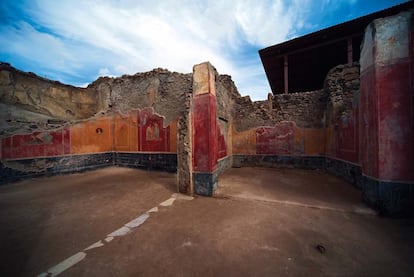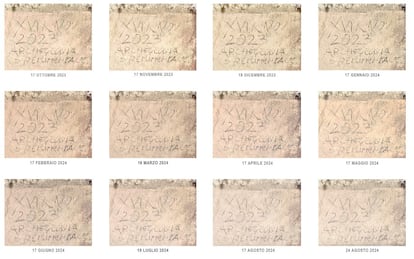Pompeii is an unparalleled treasure chest of antiquity, which has revealed countless certainties about daily life in Rome almost two millennia ago, but which also continues to hold many unknowns. One of the biggest enigmas of the city devastated by the fury of the volcano is the exact date on which Vesuvius erupted and buried everything around it under tons of ash in the year 79. A new study has reopened the debate in this regard by pointing out that “there are not enough elements to rule out” the initial official version, which placed the disaster in the summer and which had recently been relegated.
Archaeologists have not been able to certify the fateful day with certainty. Initially, the official version dated the catastrophe to August 24, because that was the date that appeared in the letter that the writer Pliny the Younger sent to Tacitus to tell him what had happened. There were always voices that pointed in another direction, towards an autumn day, probably October: they were based on the warm clothing worn by the found corpses or the charred fruits that did not correspond to a summer harvest. Defenders of this interpretation allege that the misunderstanding could have been due to a transcription error of Pliny the Younger’s letter in the Middle Ages and that the real date was October 24 or 25.
In 2018, some studies tipped the balance towards this hypothesis, based, for example, on a charcoal inscription found on the wall of a house in Pompeii dated the “sixteenth day before the Kalends of November”, which according to our current calendar It would correspond to October 17, that is, a week before the terrible eruption.
An extensive investigation, led by Italian scientists, which was published four years later in the journal Earth-Science Reviews, He considered that hypothesis to be good, which was also supported by the then director of the Pompeii archaeological park, Massimo Osanna. Apart from the inscription, the researchers also took into account the discovery of a coin, a silver denarius that bears the image of Emperor Titus, with an inscription that alluded to the month of September.
However, when the debate seemed almost settled and the official version revoked, a new experimental archeology study on the durability of charcoal inscriptions and an update of the study of literary and archaeobotanical sources have concluded that “there is currently insufficient evidence to discard the date of August 24, which already appears in the oldest manuscripts,” as explained by the management of the Pompeii Archaeological Park in a statement.
In addition, it points to the studies of the historian and archaeologist Pedar Foss, who through an analysis of the language revealed errors in translation and transcription and “was able to clearly demonstrate that all the dates, except for August 24, are pure invention, without basis. in the manuscript tradition. Although those responsible for the Pompeii site acknowledge that “this does not mean that August 24 is necessarily the correct date” and remember that in Roman times autumn began in the middle of the month that currently corresponds to August.
In a scientific article, the current director of the Pompeii archaeological park, Gabriel Zuchtriegel and other archaeologists and restorers, point out that one of the reasons that led to the date of October 24 being accepted as correct, with the proof of the inscription on the wall , was the fact that it is difficult to think that a sign made with charcoal could last a long time printed on a wall. Considering that the ashes of the volcano frozen in time everything they buried, if the inscription was made in October and the fateful eruption occurred in August – it is understood that the following year – it means that the writing lasted at least ten months. This is the theory they doubt. In October of last year, they made a charcoal writing on the same wall of the house where the inscription that changed the official version appeared in 2018. In August of this year, the text was still visible, almost as clearly as at the beginning.

The new study also raises some questions about climate changes throughout history and the geographical diversities that characterized crops and agricultural practices in the ancient world and that differ from those of today. So finding remnants of peaches, chestnuts or pomegranates together in what we now consider summer could be perfectly logical. “Necessarily seeking comparison between the models of the past and those of the present can be misleading. We must be careful not to fall into that temptation,” warn the authors of the study. And they point out: “In the Mediterranean area — a ‘hot spot’ in the study of current climate change — the climate and agricultural practices already changed in ancient times, both from one region to another and over time.”
Gabriel Zuchtriegel raises a doubt that once again shakes the history books, with the intention not of placing an end point, but of continuing the debate and opening new perspectives: “We may have underestimated the literary tradition, which in reality is not so confusing as has often been believed, or we may have overestimated the stability of the climate and agricultural cycles,” says the director of the excavations. And he points out that the climate has also changed in the past, “although at a slower pace.” In any case, “Pompeii offers a unique opportunity to study an ecosystem strongly conditioned by human presence 2,000 years ago.”

